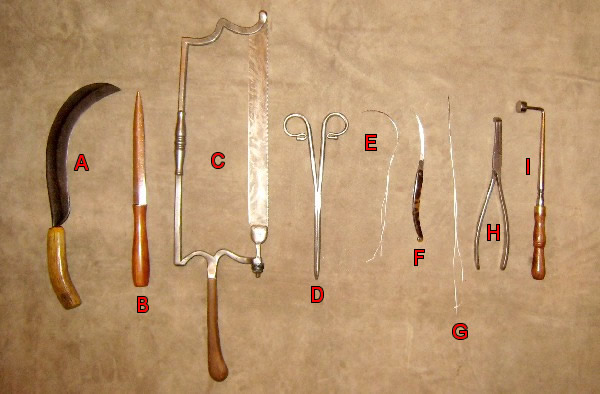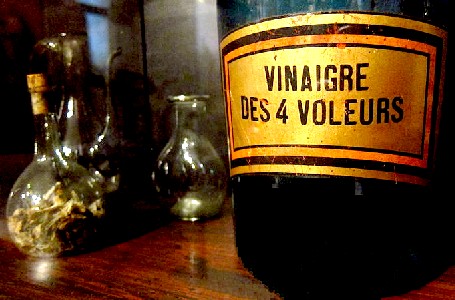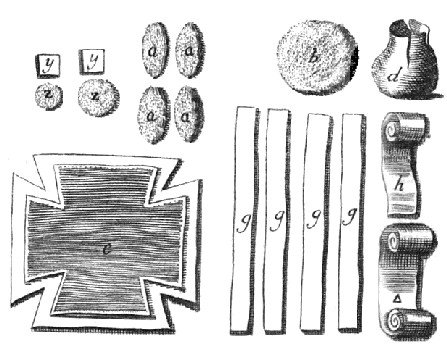
Amputation Page Menu: 1 2 3 4 5 6 7 8 9 10 11 12 Next>>
Amputation During the Golden Age of Piracy, Page 3
Surgeon Preparation
Amputating is a complex and dangerous operation. Being excruciatingly painful, preparation on the part of the surgeon before the operation could make it go that much more smoothly and quickly, saving the patient a lot of grief. Some of the things the surgeon did to prepare for amputation included readying his instruments, preparing the many bandages required and having the necessary number of assistants required to facilitate this operation.
Surgeon Preparation: Readying the Instruments
"Before the Operation we are to prepare the Apparatus which consists of whatever is necessary to its Performance which we ought to have perfectly ready laid on a Bason, that we may have nothing to ask for, and may take every thing as we want it. " (Dionis, p. 409)
Pierre Dionis is probably the most liberal in prescribing bandages, instruments and assistants for this operation. His book is meant as a textbook - something that would be used on land in a surgical class as opposed to being at sea with only the instruments and medicines the surgeon brought and whomever can be spared for the operation. Still, even at sea the surgical manual authors suggest preparing the instruments for efficient amputation.
This was particularly true when preparing the operating theater for battle. Speed was of the essence during amputation because the patient had to endure the entire operation without the aid of anesthesia. A good sea surgeon would have clean, sharp and ready instruments. John Woodall tells us, "...let the discreet Surgeon be ever prepared for [amputation], and to that end let the Dismembring saw be alwaies in readinesse, well filed, and cleane kept in oyly clouts [cloths] to save it from rust, let it also have two blades wel filed ere you put it into your [surgeon's] chest, for that one tooth in a saw may breake."1 A broken tooth in the bone saw would slow the cutting of the bone as well as require more force to be used by the surgeon when making his strokes. So one can readily appreciate the well-prepared surgeon.

|
At left: Some of Mission the surgeon's
amputating instruments as described in the text. A: The Amputation Knife - used to make the first cuts - right to the bone. Period authors also refer to it as the Capital knife, the crooked knife and the curved knife. B: The Caitlin Knife - used to cut off the periosteum (outer membrane) of the bone. C: The Bone Saw - used to cut through the bones. D: Forceps - used to clamp down on bleeding arteries. E. Curved Needle - used for sewing up the stump. F. Pocket Scalpel - used in place of the Caitlin Knife by some authors. G: Large Square Needle - used by John Woodall to sew up the stump after amputation. H: Crow's Bill Forceps - curved on the ends to reach inside a wound. Specified by Dionis for clamping arteries. I: Button Cautery - used to sear bleeding vessels by being heated red hot. |
John Atkins, author of The Navy Surgeon, provides the most succinct list of instruments for amputation: "Your Apparatus, or Apparel, should be laid in three Dishes; the first should hold your Instruments; [curved amputation or capital] Knife (A), Catlin [double-sided knife] (B), Saw (C), Arterial Forceps (D), and Needle (E)".2 In addition to those instruments, John Woodall adds "a small incision-knife (F), two great square stitching needles armed with very strong thred waxed (G) [and] ...a large boule [bowl] and some ashes therein to receive the bloud". 3 Pierre Dionis concurs with Woodall's need for a small knife, recommending the surgeon have "a large Penknife (like F, but with a smaller blade) to cut off the Flesh betwixt the two Bones [in the lower arm or leg] and the Periosteum [a membrane that encases the bones], in case that the crooked Knife [the amputation knife] has not done it..."4 He also suggests having "a Crane’s-Bill Pincers (H) on which is fix’d a noos’d thread, another pair of Nippers, with a Ring to close it, when it holds the end of the Artery".5 The noosed thread is for tying on the ends of the severed arteries to stop them from bleeding. John Moyle advised surgeons to have a "large Tape [a strip of material] for Ligature, and narrower for other occasions, [and] Cautrizing Buttons (I) ready in the fire...."6 A cauterizing button with an end shaped like a button, like the one show above.
Woodall gives us a final piece of advice regarding the surgical instruments. "All the necessaries as is said made ready to the worke, and in the name of the Almighty, the sharpe instruments being as neere as you can hidden from the eyes of the patient..."7 I guess he felt there was no sense in scaring the poor chap too soon.
1 John Woodall, the surgions mate, p. 172; 2 John Atkins, The Navy Surgeon, p. 123-4; 3 Woodall, p. 172; 4 Pierre Dionis, A course of chirurgical operations: demonstrated in the royal garden at Paris. 2nd ed., p. 409-10; 5 Dionis, p. 410; 6 John Moyle, Memoirs: Of many Extraordinary Cures, p. 119; 7 Woodall, p. 173
Surgeon Preparation: Preparing the Bandages
"The Preparatives are numerous, for we are to double the number of Pledgets [compresses of absorbent material, often lint], Astringents and Bolsters [absorbent pads], that nothing may be wanting; and all this requiring Time 'tis done out of the Patient's Presence, that he may not be terrified at the sight of so much Lint, and so many Bolsters and Bands [of material]." -Pierre Dionis, p. 409
It's interesting to me that Dionis thinks the number of bandages would concern the patient. I would think, as Woodall does, that the amputation knife or bone saw would be of greater concern. In any event, it is widely recommended by the period surgical authors to prepare the bandaging for ready access during amputation.

Medicinal Vinegar
Richard Wiseman tells his readers that he would have "prepared Dressings ready; which were Stupes or Pledgits of fine short Tow well workt [made soft], some [shaped] like Splenia, others were round, and bigger or less. We wetted them all in Oxycrate [an astringent of water and vinegar], and dried them.
We also made some Buttons of Tow [inexpensive linen cloth folded like a large button], Compresses of linen Cloths dipt in Oxycrate, three or four Rowlers [roller bandages] with one or two heads [two-headed rollers are split at the end]; provided Needles threaded and ceared [waxed] for making the cross Stitch [across the end of the stump], and lesser Needles threaded for common use, with Filleting [ribbons of cloth] for Ligature, and Bladders [ox and pig bladders were used to seal the stump after it was bandaged as the membranous structure stopped leakage] ready cut and wet in Oxycrate; also a Defensative of the above-mentioned prescription spred upon a soft linen Cloth, to apply upon the Parts above more distant, and a Mixture of the astringent Powders with Whites of Eggs, to spread upon the Splenia and Buttons [types of pads], which Buttons were also dipt in some of the same Powders."1
Most of the other surgical authors who talk about the bandages vary in what sorts they recommend, but generally agree with Wiseman that vinegar and water be placed on them as a defensive measure and whites of eggs be used of stemming bleeding. The ever descriptive Pierre Dionis gives us another account with a bit more detail and a nice diagram for reference.

Taken from figure XLVII "For Amputation", A course of chirurgical operations: demonstrated
in the royal garden at Paris. 2nd ed, by Pierre Dionis, p. 403
"...to dress the Patient, we must have three small square Bolsters [Y Y] to lay on the ends of the Vessels, two Pledgets [those marked z] dipt in Spirit of Wine to lay on the Bones which are cut, a numerous quantity of Pledgets charg'd with Astringents [those marked a], with which we are to cover the whole Wound, a Stopple [a piece of cloth] made of tow about the size of the bottom of a Plate, to take in [encompass] the whole Stump [b], and cover'd with Astringents; a Bladder [d], at the bottom of which are Astringent Powders, and which is cleft to slip the Stump into it, a large Plaister and Bolster cut like a Maltese Cross [e], four long Bolsters [those labeled g] of half an Ell long [an ell is the length from a man's elbow to the tip of his middle finger] and two Fingers breadth broad, a Band rolled up at one end [h], another of four or five Ells long, of the breadth of four Fingers, and roll'd up at both ends [Δ], in order to make the Bandage which we call the Cap of Maintenance, and several Napkins [pieces of cloth for use and disposal, not shown] for necessary occasions."2
1 Richard Wiseman, Of Wounds, Severall Chirurgicall Treatises, p. 454; 2 Pierre Dionis, A course of chirurgical operations: demonstrated in the royal garden at Paris. 2nd ed., p. 410
Surgeon Preparation: Assigning Assistants
Several assistants were required to complete an amputation. The surgical authors from the Golden Age of Piracy varied a great deal in the number of assistants they recommended during the operation. It may even be surprising to learn how many were specified until one remembers that the patient would be in an extraordinary amount of pain, requiring people to hold them down in addition to those who assisted the surgeon. We'll begin with the ever-elaborate Pierre Dionis' description of who was needed to complete a proper amputation.
"We are to cause the Patient to be seated on the edge or end of the Bed, held up by a Servant, who kneels behind him, and on whose Stomach he leans; we cause a Servant to sit also on the side of the Patient on which we are to perform the Operation, who grasping with his two Hands the lower part of the Thigh, draws the Skin upwards as much as possibly he can, whilst the Operator [surgeon] is fixing on the Ligatures; We wrap the Leg round with [a] Napkin, as it were as far as the Place where we are going to make the Incision, and cause it to be Held by a third Servant placed directly

Dionis' choice of assistants, from a painting of an amputation in the men's theatre
in St. Thomas' Hospital, artist unknown, 1775 or 1776
opposite to the Patient, kneeling on one Knee, and holding it up a convenient height: A fourth Servant is charged with Instruments, and placed next the Operator, and the Apparatus for the dressing is held by another Servant: Nor can we be without a sixth, who is to obey the Order of the Operator; so that a great many Servants are necessary on these Occasions."1
Dionis certainly holds the record, specifying six people to help him perform his operation.
Unfortunately, when a surgeon was working on a ship, he usually didn't have the luxury of having this many men to work with. This was especially true when he probably needed them the most - during a battle. Most pirate surgeons would have been abducted from merchant ships. Such ships were lightly manned. If a merchant vessel wound up in a battle (say with pirates), every man would be needed to be fighting if possible. As Richard Wiseman wryly notes, "At Sea they sit or lie [during amputation], I never took much notice which; nor do I remember I had ever any body to hold them; but with the help of my [Surgeon's] Mates, and some one or two that belonged to the Hold, I went on with my work."2
Even so, he hints at having at least two or three men assisting him (depending on how many surgeon's mates or surgeon's assistants he had working with him.) Wiseman later explains that, "The Member is to be supported by some one, whilst another standeth behind the Patient, and draweth up the Skin and Musculous flesh."3 Being a military surgeon, he would usually have had the luxury of having more people available to assist him than most merchant ship surgeons, despite his comments indicating otherwise.
Sea-surgeon John Moyle suggests having three helpers. "Let one man be at the Patients back holding him, and another before him holding the upper part of the Limb; and a Third holding that Part that must be taken off."3 Matthias Purmann also suggests at least three other people, explaining that as a surgeon you would "place one of your Men at the Foot to hold the Leg fast, behind the Patient place a lusty strong Man to hold him, and other people to hold the other Leg, that you may be no way molested in what you are about."5 So we can safely say that two or three assistants would be on hand for most amputations during this period if that were possible.
1 Pierre Dionis, p. 410-1; 2 Richard Wiseman, Of Wounds, Severall Chirurgicall Treatises, p. 452; 3 Ibid; 4 Moyle, p. 51; 5 Matthias Gottfried Purmann, Churgia Curiosa, p. 210

